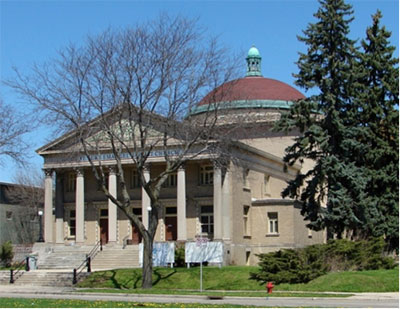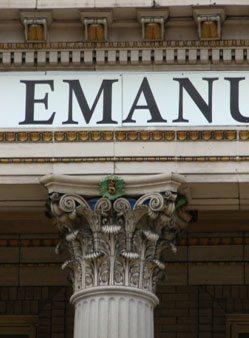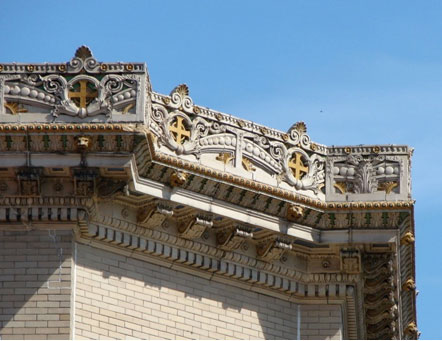8. Second Church of Christ, Scientist, 1913
Now St. Luke Emanuel Baptist
2722 West Highland Boulevard
Architect: Carl Barkhausen
Milwaukee’s Christian Science Association, organized in 1884, was the first such association outside of Massachusetts, where the Christian Science denomination had been founded five years earlier. There are two earlier buildings in Milwaukee that are associated with the denomination and are still standing, although neither is currently used as a Christian Science church. The older of the two buildings is a Gothic Revival style church on Van Buren Street between State Street and Juneau Avenue, built in 1902. It was initially known as the Christian Science Society rather than the First Church of Christ, Scientist. The building originally known as the First Church of Christ, Scientist is a neoclassical building on Prospect Avenue at Curtis Place, built in 1907.
The First Church could accommodate more than 1,000 worshippers, but proved to be too small for the rapidly growing denomination even when it first opened. A second congregation was therefore organized in 1909. This new congregation acquired property on Highland Boulevard and began construction of the present church in 1913. It is substantially larger than the first church, with seating for up to 1,450 worshippers.
Milwaukee architect Carl Barkhausen was commissioned to design the church. Barkhausen (1860-1934) was born in Thiensville, Wisconsin, to German immigrant parents. At the age of 16, he went to Germany to study architecture in Hanover and Berlin. Returning to Wisconsin in the early 1880s, Barkhausen apprenticed in the office of Edward Townsend Mix, Milwaukee’s most prominent architect at that time. He later formed a partnership with Charles Crane, who had also worked in the Mix office.
Leaving the partnership just after the turn of the century, Barkhausen went to New York to work for the Fuller Company. Founded by Chicago architect George A. Fuller, this innovative firm created the role of the modern general contractor. By overseeing all aspects of a construction project based on a single bid price, the general contracting system allowed architects to concentrate on design by relieving them of the much of the construction supervision and coordination of subcontractors that they had previously been required to perform. The Fuller Company built many of New York’s early skyscrapers. Barkhausen returned to Milwaukee in 1913 and established his own office, where he continued to practice until his death in 1934.
The Second Christian Science Church is similar in form and many of its details to the Madison Square Presbyterian Church in New York City, designed by the renowned firm of McKim, Mead and White and completed in 1906 (and demolished in 1919). Barkhausen was undoubtedly familiar with this building from his time in New York. The New York church was considerably taller and more compact in plan, but had a six-column temple front, a low dome surmounted by a small lantern, and terra cotta trim. The forms of both buildings are ultimately derived from the Pantheon in Rome, constructed in the early second century AD. The terra cotta cornices of the Second Christian Science Church exhibit designs of unusual intricacy and multiple colors, unmatched by that of any other religious building (or possibly any building) in Milwaukee.
After more than six decades at the Highland Boulevard location, the Christian Science Church sold the building in the mid-1980s to its current occupant, St. Luke Emanuel Baptist Church.
Sources:
“C. Barkhausen Dies Suddenly,” Milwaukee Journal, December 13, 1934, page 19, column 1.
Gregory, John G. History of Milwaukee, Wisconsin, volume 4. Clarke Publishing Company, 1931.
Turner, Diane. “The Growth of Christian Science in Milwaukee.” Unpublished typescript dated 1978. In the Church Papers of the Milwaukee County Historical Society Library.



